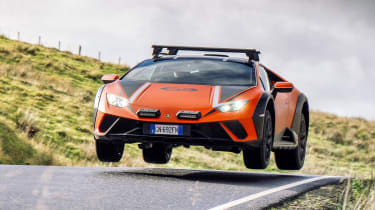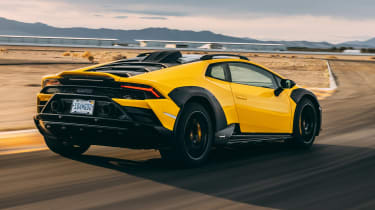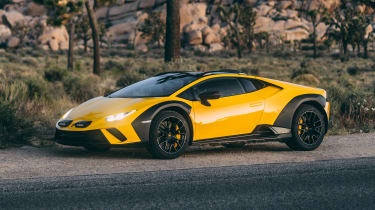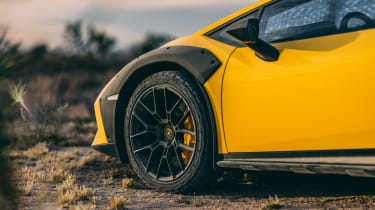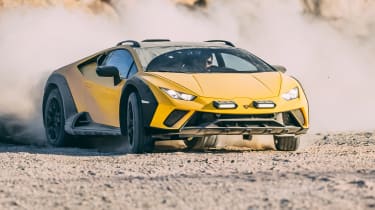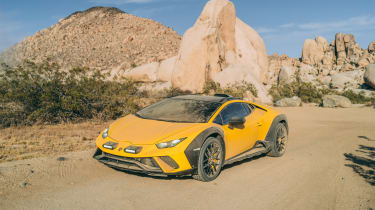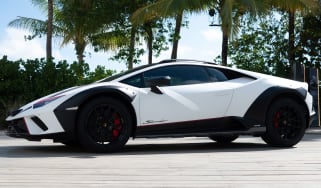Lamborghini Huracán Sterrato 2023 review: a new breed of supercar
The final Huracán derivative is its most extreme interpretation – and yet the most usable version of all. It’s also enormous fun
The Lamborghini Huracán Sterrato, by rights, is a car that shouldn’t make sense. And yet…
It rides beautifully, making it the most comfortable Huracán yet devised. Speedbumps and potholes are no barrier and parking spaces can be improvised. It has the same enthralling 5.2-litre V10 engine as before and the acceleration and soundtrack that comes with it, and the same visual drama too: the Huracán’s body wears the rally-inspired arch cladding, spotlights and snorkel well.
And, as it turns out, it’s a riot to drive on the track – and off it, on sand, gravel and dust. ‘The interesting thing about this car,’ smiles Lamborghini’s head of marketing and sales, Federico Foschini, ‘is that the most extreme Huracán and the most comfortable Huracán are actually the same thing.’
> Lamborghini Revuelto revealed: all the details on the Aventador replacement
The Huracán Sterrato (‘dirt road’ in Italian) is not a car born from the marketing department, however. It came entirely from Lamborghini’s R&D and design teams, beginning life as an inside-job, skunkworks project.
‘[Former Lamborghini chief technical officer] Maurizio Reggiani was convinced the Huracán’s four-wheel-drive system was capable of doing something like this,’ Foschini says. ‘And in 2017, a prototype was built…’
More reviews
Head of design Mitja Borkert takes up the story: ‘I was new at Lamborghini then, and we were finishing the Urus SUV. We were driving off-road at the Nardo test centre in Italy, and we were saying: “Now Lamborghini has this new component of going off road and going sideways [on loose surfaces] – why aren’t we looking at transferring this to other models too?” And the Huracán, with the short wheelbase and the V10 engine, would be the perfect car…’
‘We made a one third-scale design model, and Rouven Mohr (now Lamborghini’s CTO, then head of whole vehicle development and hard at work on the Urus), liked it a lot; we both love old rally cars. I said to him, “why don’t we build a demonstrator?” He said, “yeah, we have a Huracán Performante development car free.” I set about designing the cladding and so on…’
‘Everyone fell in love with it – especially when they drove it. It was our baby of R&D that we were proud of but it was not the time to release it.’ When Stephan Winkelmann returned to Lamborghini as CEO in 2020, during ‘the longest design meeting in history,’ a production version got the green light. ‘When we showed him the Sterrato, he said: “That’s what we need to do,”’ Borkert says. ‘It fitted in with his “always different” philosophy for the brand.’
Fast-forward to 2023 and the production-spec Huracán Sterrato is here, in front of us under Californian sunshine and ready to drive. In the UK, it’s priced at £232,820, around £29,000 more than the Huracán Tecnica (although most customers across all markets are expected to spec between €30-40k on options – which include the separate spotlamp pods, roofbars and optional liveries, including a Lancia Stratos-esque Alitalia-inspired graphic scheme).
It is limited to 1499 cars globally (a number which changed more than once, Mohr mentions, after the Sterrato sold out more quickly than expected when first revealed). Nearly half will be sold in the USA, with Europe and the Middle East the next biggest markets.
The roofscoop air intake is standard-fit to better feed clean air to the V10. ‘This was the last feature added,’ Borkert says. ‘It came from testing: because when you go sideways, the air to the normal vents ahead of the rear wheels gets closed…’)
Clamber in and the main visual difference inside versus a ‘regular’ Huracán is the discovery that the snorkel system almost totally blocks the main rearview mirror. In a Huracán STO, you can see through the engine cover’s slats like looking through the ribcage of a carbonfibre creature. In the Sterrato, there are only tiny chinks of daylight either side of the new snorkel in the main mirror, and without a permanent camera screen you’re more or less totally reliant on the door mirrors once you’re on the move.
Heavy-duty floormats aside, the other main interior differences are a new suite of off-road displays for the touchscreen, with compass, inclinometer and steering angle graphics, and a key word change on the drive mode switch on the steering wheel: in place of Corsa, there’s Rally mode.
We’ll discover what that entails on (and off) track shortly, but first the road. Frustratingly, that predominantly involves heavily trafficked freeways and a diversion through a visually striking but busy, blind-cornered and strictly speed-limited national park. It reveals a lot about the Sterrato’s refinement and usability; at brisk motorway cruising speed the all-season tyres (run-flat Bridgestone Duelers, of a construction developed specifically for the car) are actually very quiet (on admittedly smooth-surfaced roads) – certainly far less noise gets into the cabin than in Porsche’s 911 Dakar and in older generations of the Huracán, which could be really hard work on a long trip. It’s easy to hold a conversation without raising your voice.
There’s still nowhere to put anything in the cabin and the boot in the nose is still tiny but you do now have the option of roofbars, which could make this the most practical Huracán for road trips yet. Especially as you can easily leave the tarmac and explore, to at least the same extent as you could in a regular car, if not an SUV: we dive off the road and take a quick tour around a campground, just because we can, and in town it’s easy to drive up and down access ramps or over broken tarmac without a second thought.
It’s certainly no Land Rover – Mohr explains that the Sterrato’s remit is ‘to go full throttle on a gravel stage, for fun,’ rather than to climb over ruts and obstacles, and it’s a different proposition to the 911 Dakar, which is capable of more hardy climbing and clambering.
The road stint reveals less about how the Sterrato feels dynamically at speed. There is more pitch and roll than a regular Huracán, of course; the ride height is 44mm higher (it sits, very approximately, as high as the regular car does when its nose lift is activated), the springs are 25 per cent softer and they’re longer too, by around 34mm, for the requisite extra travel. The dampers too are longer but essentially the same adaptive units as the regular Huracán’s, from the same supplier.
The road-focused Strada mode and firmer Sport settings have been recalibrated accordingly; turn the wheel in Strada and there is just a fractional latency between the steering wheel’s movement and the body following. It’s far from wallowy, and the ensuing body roll is very well contained. The steering is a little lighter than in a normal Huracán, no doubt down simply to the treadblocks on the tyres, but there’s still enough feedback to feel what’s going on. The car behaves broadly the same in Sport at low-ish speeds: just a smidge more weight to the steering, a smidge less roll as the dampers firm up and a lot more noise from the exhaust system. This is a very loud car when the taps are open.
And a very, very quick one. Top speed is limited to 162mph, partly for the tyres and partly because the car’s raised suspension set-up could lead to some unpredictable stability traits if the Sterrato was allowed to reach the very high speeds of its stablemates. But that’s still a sports car-worthy top speed, and it’s still supercar quick in terms of acceleration. And the sound and throttle response of the naturally-aspirated V10 is as glorious as ever. It’s a lovely engine to spend time with.
Sport mode also bundles much more of the torque (split actively by the same system as regular all-wheel-drive Huracán models) to the rear; as much as 80 per cent if conditions allow. On the circuit – a rallycross track specially constructed for Lamborghini at Chuckwalla Valley Raceway east of Palm Springs, more than 2.5 miles long and split more or less equally between tarmac and dirt – we flick between Sport mode for the black stuff and the Sterrato’s new Rally mode for the loose surface sections.
It’s enormous fun. On tarmac, there’s much more pitch under braking than in a normal supercar but it’s well controlled, and it’s possible (and encouraged by Lamborghini’s chief test driver Mario Fasanetto, sitting in the passenger seat alongside) to use that weight transfer to loosen the Sterrato’s rear and then balance it in a slide. Unlike other current Huracáns, the Sterrato does not have rear-wheel steering (it felt unnatural in response when paired with the all-terrain tyres in testing, Rouven Mohr explains) and its torque vectoring by braking system has been reprogrammed. In a more (tarmac) track-focused Huracán such as the STO, the inside rear brake is nipped to help agility on turn-in; in the Sterrato, it’s more about supporting the car’s stability once it’s in a drift.
We dive headlong off the circuit and onto the dirt loop, flicking the drive mode switch to Rally mode just before the tyres leave the tarmac. It’s a long, technical series of tight hairpins, short straights and very fast, flowing curves, some at the top of third gear. It’s not a gentle course: there are some wicked ruts and the suspension hits the bump stops in several places. Fasanetto says not to worry: ‘Keep pushing, change up, next gear.’
It’s a car you very quickly feel comfortable with; almost immediately on the loose stuff your hands are crossed, applying opposite lock, without really thinking about it. It takes some learning to get the best from: you need to get on the power early, get the all-wheel-drive engaged, and then use all that lovely headroom of an 8500rpm ceiling and naturally-aspirated throttle response to make the best of it. It’s been deliberately set up with an oversteer balance but there’s still plenty of traction; and you accelerate and gather pace rapidly even on loose sand.
It feels incongruous to be sat in a low-set supercar driving position, that shallow-angled Lamborghini windscreen ahead, and that V10 engine yapping and yowling behind you, while seeing torrents of sand arc upwards from the front wheels, or to hold a Huracán in a controlled slide at an angle that must look like madness from the outside but feels serene from inside the car.
It’s huge fun.
And, ironically, the Sterrato might in some ways be the pick of the bunch: the perfect Huracán for the UK’s pockmarked, battle-scarred roads. All a moot point because the Sterrato’s run is sold out. And although there will be a further 60th Anniversary special-edition Huracán based on the regular, tarmac based car before the model line fully bows out at the end of 2024, this is the last new derivative to be spun from the Huracán’s now decade-old platform.
And it’s a swansong for the V10 engine, as the Huracán’s replacement, to be revealed in 2024, is expected to be powered by a hybrid V8 powertrain. It’s a fabulous way for it to go out: a bold, boundary-pushing Lamborghini that, in many ways, unlocks more of the Huracán’s potential than anyone could have imagined at the beginning of its lifespan.
Why it made eCoty 2023
If Lamborghini was a regular car company, the Huracán would have peaked with the STO in 2021, the perfect end to the mid-engined phenomenon that terrified eardrums with its savage V10 soundtrack and a performance punch to match its Super Trofeo race-car DNA. As going out on a high goes, the STO would be hard to beat. But then two further editions broke free of Sant’Agata in the form of the Tecnica and, of course, the Sterrato.
Either could have made the cut for our 2023 Car of the Year test, but while the former takes the best of the STO and Evo models to create a modern- day Lamborghini that, despite its perceived old-school approach, has plenty to keep today’s technical hot shots on their toes, the Sterrato is genuinely something else. An unknown with an approach to the thrill of driving normally reserved for the likes of a Bowler Defender or Ariel Nomad.
It is unique in this year’s test. The only ‘special’ and a car that will need to impress beyond its ability to fi ll a smartphone’s photo library in a single pass down Hexham high street. The Sterrato could go down a hero, swat the supercars into the weeds, bat the super-sports cars away and leave the Type R quivering in its V10 wake. Or we could all have a go, step out of it with a bladder barely under control through laughing so hard and decide ‘Yep, that was fun, but I don’t need to drive it again. Next!’
That’s the issue with bespoke specials: they’re fun in the moment, but the appeal wanes and the veneer cracks as you prod harder and scrutinise the detail more thoroughly. The Sterrato has its work cut out to defy the stereotype.
Lamborghini Huracán Sterrato specs
| Engine | V10, 5204cc |
| Power | 602bhp @ 8000rpm |
| Torque | 412lb ft @ 6500rpm |
| Weight | 1470kg (dry) |
| Power to weight | 410bhp/ton (based on dry weight) |
| 0-62mph | 3.4sec |
| Top speed | 162mph (limited) |
